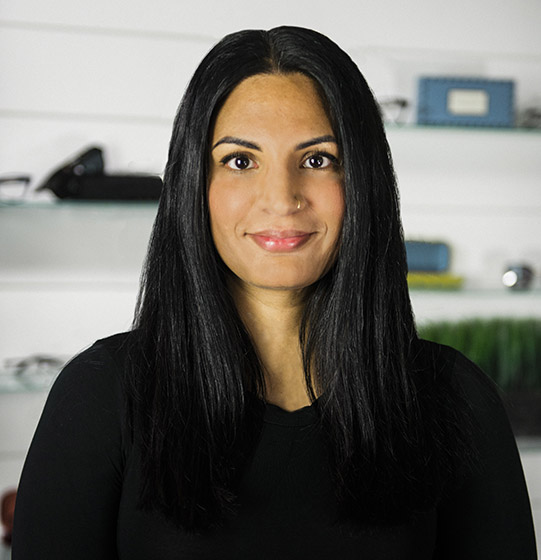Many Canadians develop cataracts as they age, and cataracts are most commonly found in individuals over 60 years old. Cataracts cause a normally clear lens to cloud over, gradually impairing vision. The size and severity of cataracts can vary widely: from small areas of minor cloudiness to large opaque areas that significantly impede vision.
Cataracts can form slowly over many years, or rapidly over the course of a few months. The only way to definitively determine if you have cataracts is to undergo a comprehensive eye exam.
Cataracts Signs & Symptoms
Signs and symptoms of cataracts include:
- Blurry, clouded, or dim vision
- Trouble seeing clearly at night
- Increased sensitivity to light and glare
- Fading or yellowing of colours
- Seeing halos around lights
- Double vision in a single eye
- Requiring stronger lights for reading and other close up activities
- Frequent fluctuations in your eyeglass or contact lens prescription
At first, the cataract may minimally impact your vision so you may not even realize that a cataract is developing. However, as the cataract grows, it clouds more of your lens, distorting light and causing more noticeable symptoms.
If you ever notice any changes in your vision, such as double vision, flashes of light, sudden eye pain, or sudden headaches, you should make an appointment with your optometrist as soon as possible.
How Do Cataracts Develop?
Age is the most common cause of cataracts, but this gradual clouding of the lens can also be caused by trauma, steroid medications, diabetes, and prolonged exposure to UV light. Individuals who smoke are more likely to develop cataracts, but in rare cases, infants can be born with this condition.
Cataracts affect your eye’s lens, which is positioned behind the coloured portion of your eye (the iris). The lens focuses the light that passes through your eye, creating a clear, sharp image on your retina. As we age, our lenses thicken, lose transparency, and become less flexible. Slowly, the tissues within the lens begin to break down, clumping together and clouding small areas of the lens. This clumping and clouding are what causes cataracts.
As the cataract progresses, it becomes larger and more opaque. Cataracts block and scatter light, preventing the lens from projecting a clear image onto the retina and causing blurry vision.
While cataracts typically develop in both eyes, they don’t tend to do so evenly. A cataract in one eye may be larger and more opaque than its counterpart, causing a difference in vision between the two eyes.
Factors that Contribute to Cataract Development
Several factors may make you more likely to develop cataracts, may help contribute to the development of cataracts at a younger age, or speed up cataract progression. These factors include:
- UV light. UV light may contribute to the development and progression of cataracts, which is why you should always wear sunglasses that block UV light when you are outside.
- Diabetes. Individuals with diabetes are up to 60% more likely to develop cataracts than individuals without diabetes.
- Smoking. Individuals who smoke are more likely to develop cataracts than nonsmokers.
- Excessive alcohol use. Excessive alcohol use may increase your chances of developing cataracts.
Can Cataract Progression Be Slowed?
There have not been any studies that support definitive strategies for preventing cataracts or slowing their progression. Though there are a number of things you can do to help reduce your chances of developing cataracts once a cataract forms the only way to treat it is through surgery.
Preventing Cataracts
There are several things you can do to help reduce your chances of developing cataracts or detect them early on:
- Going for regular eye exams. While regular eye exams can’t prevent cataracts or slow their progression, they can help your optometrist detect cataracts and other eye problems in their earliest stages.
- Choosing a healthy diet. Fruits and vegetables such as red beans, blueberries, cranberries, strawberries, raspberries, apples, prunes, artichokes, kale, and broccoli and nuts such as pecans are all rich in antioxidants, which help maintain your overall eye health and reduce your chances of developing cataracts.
- Wearing UV blocking sunglasses. UV blocking sunglasses can help reduce your chance of developing cataracts.
Cataract Treatments
Non-Surgical
In their early stages, when your vision is minimally affected, your optometrist may be able to suggest workarounds to maximize your remaining sharp vision. Possible strategies include:
- Adjusting your prescription. New lenses may be able to provide you with the sharpest, clearest vision possible.
- Using magnifiers and other visual aids. A magnifying glass or a strong reading light may help you read small print and perform other close up tasks. Increasing the text size on your phone, tablet, or computer can also help you maximize your remaining clear vision.
Surgical
Currently, the only way to treat cataracts is through surgery. Cataract surgery is incredibly safe and involves removing the clouded lens and replacing it with a clear artificial one. Your optometrist will help you determine when your cataracts have progressed enough to consider surgery.Cataract surgery is 95% effective, and we are here to support you every step of the way. To help you safeguard your vision, we offer cataract surgery referrals. We only refer our patients to the best ophthalmologists in the Sherwood Park area and will provide you with pre and postoperative care and instructions, and adjust your prescription as necessary to ensure you can enjoy the clearest possible vision.



